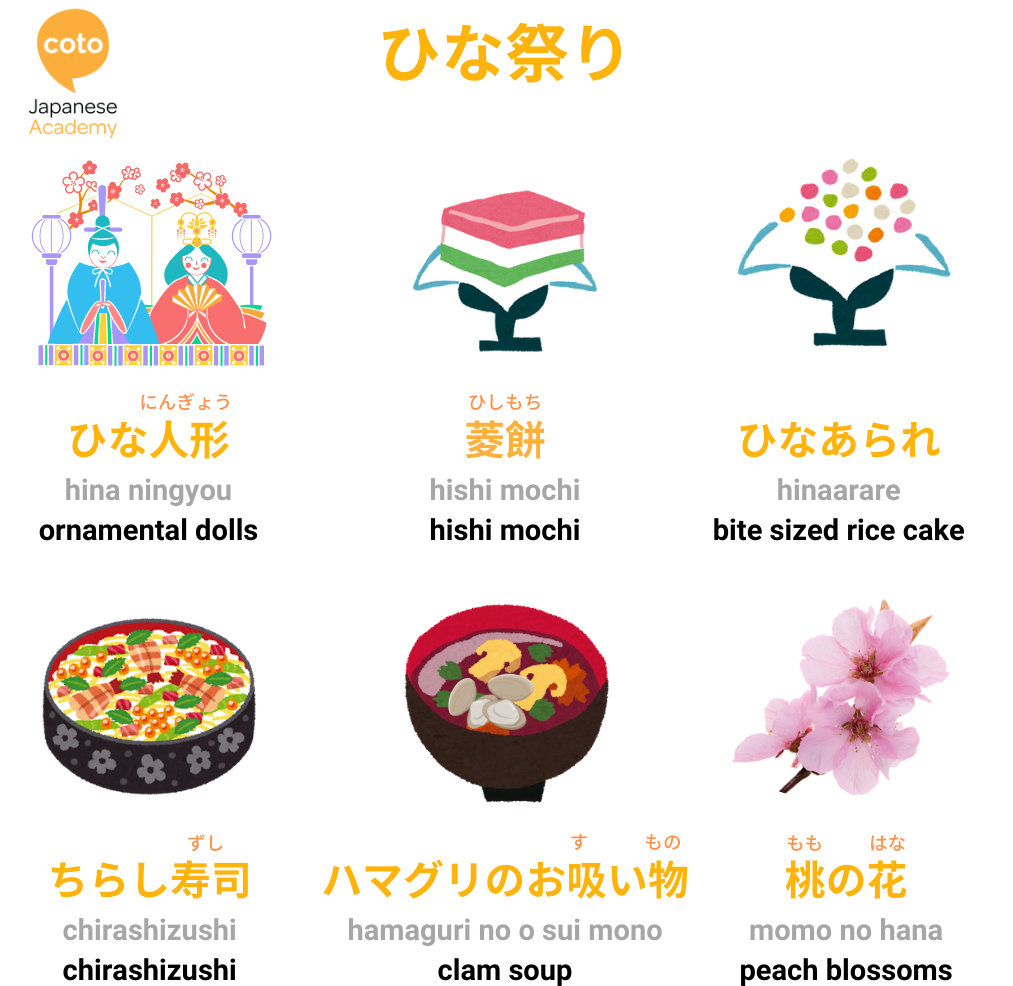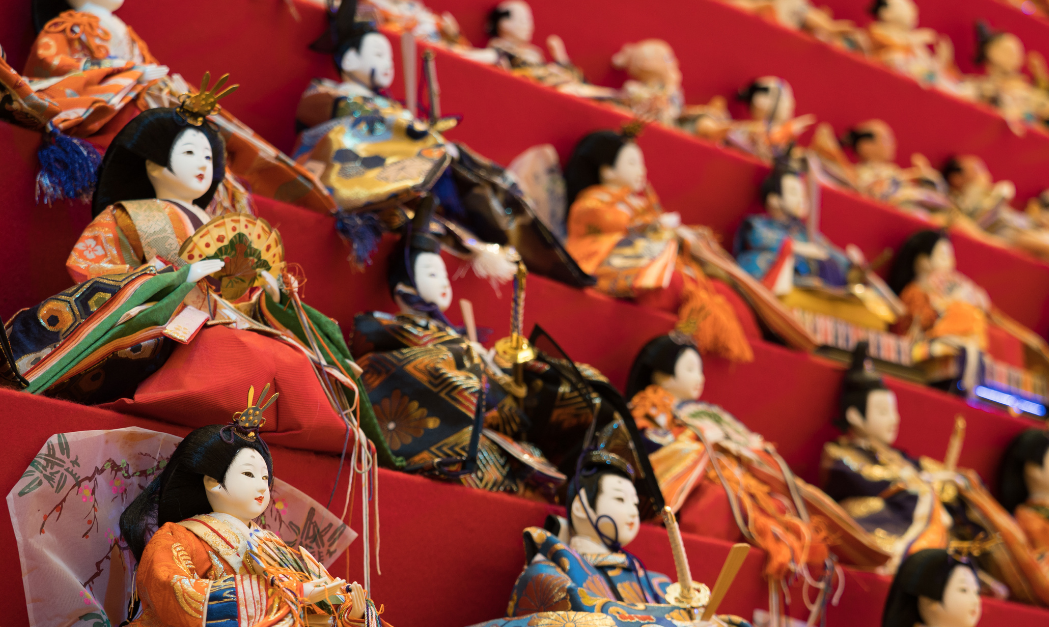Close to the beginning of spring in Japan, shrines and houses will start to display ornately dressed figurines — tiny dolls, clad in traditional robes reminiscent of the imperial period – for the Hinamatsuri Festival
The sight is all at once alluring and mysterious: What do these small ceramics represent?
When the question pops, that is when you know Hinamatsuri is approasching. Celebrated every year on March 3, it goes by different names: Japan’s Doll Festival, Girl’s Day and formerly Peach Festival (Momo no Sekku).
It isn’t a well-known Japanese tradition compared to other celebrations like setsubun or shogatsu (New Year). That said, it’s still an important, grassroots event to the people. So what is it, and why are these dolls considered a cultural treasure in the present day?
Jump to:
- What is Hinamatsuri?
- History of Hinamatsuri
- Dolls in Hinamatsuri
- Celebrating Womankind and Young Girls in Hinamatsuri
What is Hinamatsuri?
Hinamatsuri is an annual festival held on March 3. It’s a day where families pray for their daughter’s health, longevity and prosperity. During this time, families will set up new or heirloom dolls.
They’re made of ceramic, intricate in details and heavy in Japanese craftsmanship. Tiered platforms, draped with red carpet, set the stage for the ornamental dolls.
The question remains: Why dolls? In Japan, dolls, called ningyou (人形), are believed to be containers of bad spirits, and the custom to display them travels back to the 9th century.
On odd-numbered dates and months like March 3, it’s considered the perfect time to cleanse malevolent spirits and ward off bad fortune. The dolls become a medium to store evil.
Hinamatsuri is one of the five seasonal festivals in Japan, also known as sekku (節句). These events were originally brought to Japan during the Nara period from the Chinese dynasty.
Each sekku festivals has its own significance, traditional offerings, seasonal flowers and plants: spring herbs, myrtle root, chrysanthemums and bamboo. Together, they are collectively called gosekku, meaning “five main festivals”.
Sekku festivals fall on odd-numbered days. For example, the first one, oshogatsu, is on January 1, followed by Hinamatsuri (March 3), Tanabata (July 7) and Kiku Matsuri (September 9).
Tango no Sekku marks the beginning of summer or the rainy season. The doubling of odd numbers on both the month and date makes the day auspicious to ward off evil spirit and bad omen.
Initially, the hina dolls were used as toys, but they are also used as emblems for purifications rituals. Eventually, Hinamatsuri becomes a day where families pray and give thanks for their daughter’s longevity, fertility and health.
Although it’s no longer known as Peach Festival, peaches remain a symbolic element of the festival, too. The trees bloom the fruits around the beginning of March, becoming both a harbinger of spring and a ward to spirits.
In certain regions in Japan, the tradition of nagashi-bina (“doll floating”) is still honored. Predating the Hinamatsuri, families will make dolls out of paper or straw. They are then discarded, sent on a boat down a river while bringing the impurities and sins along with them.

History of Hinamatsuri
The tale of Hinamatsuri’s origin is a simple one. In the 16th century, when Hinamatsuri was just a small part of the Peach Festival rather than its own holiday, Emperor Go-Mizunoo’s daughter, Oki-ko, would play her dolls, set up by the imperial court ladies — an act called hina asobi (“doll play”).
When she became the empress, she legally made Hinamatsuri the name of the holiday.
The annual doll festival began to be more elaborate, with dolls growing larger than the year before (some are over one metre tall). Overtime, hinakazari evolved in numbers, growing from one doll to two pairs, and eventually fifteen personals.
The Meiji period marks Japan’s modernized take on Hinamatsuri. After losing popularity for a few years, it was revived and aimed at marriage and families.
In a time when the nation was fostering the emperor’s power, Hinamatsuri is the perfect blend of Japanese values: emperor and empress, as a symbol of the throne, and civilian families’ hopes on prosperity.
Tiered Hina Dolls in Hinamatsuri
The seated male and female dolls (obina and mebina) are the most enchanting part of the whole Hinamatsuri. The dolls sit on a red-carpeted, tiered doll stand called the hinadan (雛壇).
Placed on the highest level, you’ll find a pair of dolls representing the emperor (odairisama) on the left and the empress (ohinasama) on the right. In Kanto-style arrangements, it’s the opposite: the male doll will be placed on the left.
Together, they are called dairibina (imperial dolls). A golden screen is placed behind them, reminiscent of the real Imperial throne of the ancient court.
On the second level, three ladies of the court await, called the “sanin kanjo“. Just below them are musicians and other attendants.
A more elaborate hinazakari (the entire set of dolls and accessories) may include servants, guards, regalia and beautiful furniture ornamented in each step.

The size of the platform, its number of steps and the dolls’ size may vary but most homes will only present a one-step platform with 2 dolls: the emperor and empress. The entire display of ceramic dolls is said to mimic a scene of a Japanese wedding in the Heian period.
You can usually see the hinazakari from February, in temples, shrines, and homes. The displayed dolls, however, have to be taken down right after the festival ends. Leaving the dolls past March 4 is counter-effective, as they become a bad omen for late marriages for the family’s daughter.
Although the dolls can be as simple as folded paper dolls (origami), most families will buy in a pair of hinaningyou. They often buy a new set of dolls before their daughter’s first Hinamatsuri.
Depending on the quality, a set of five-tiered dolls can cost up to $2,500. Still, they are considered an investment and valuable possession in the home, hold dear by both the girls and the entire household.
Like what you’re reading and want to explore more Japanese culture? Check out our top picks for you:
Obon: A Japanese Tradition Honoring The Ancestors’ Spirits
New Year’s Day (元日): A Time for Tradition
Culture Day: The Holiday that Commemorates Peace
Setsubun: Ultimate Guide to Welcoming a New Season in Japan
The hinaningyou can be passed down from generation to generation. They’re stored in storage for most of the year. In the days leading to the Hinamatsuri on March 3, girls and their mother will begin setting up the hinakazari (boys don’t normally get involved).
The entire process of setting up and taking down the hinadan requires time and effort, and the dolls are extremely fragile too. Now, you can find a compact set of prearranged dolls enclosed in a glass.
Many families are also opting for a pair of only the Emperor and Empress dolls.
Celebrating Womankind and Young Girls in Hinamatsuri

During Hinamatsuri, people pray for the happiness and the well-being of the girls. This is particularly important for families who have young daughters.
Besides that, you’ll get to enjoy assortments of sweets and special dishes. It’s customary to eat food the color of white, pink and green.
Hishi mochi, for example, is a multi-colored rice cake. The green layer represents spring and life; the white represents longevity; and fertility and the pink represents health. Hina-arare is another treat that (literally) adds another crunch to the festival. They’re a type of rice crackers that consists of the same color.
Besides that, families will invite guests for parties and allow them to admire the hinazakari. They’ll serve chirashi-zushi, a kind of vinegared rice with hefty ingredients of vegetables, omelets and raw food.
Besides that, clam soup is brought to the table — a “joined pair”. Although the girls are not of age yet, they get to try amazake, a non-alcoholic, thick and beige-colored beverage made from fermented rice.
In a country where the culture was dominated by men, Hinamatsuri becomes an event to bring forth womankind. Its counterpart, Children’s Day, is celebrated on May 5 for young boys.
Credit CC BY-SA 4.0: Japanexperterna.se
Title: Kumamon Hina Dolls
www.japanexperterna.se Flickr
How do Japanese celebrate Girl's Day?
During hinamatsuri, people will display traditional dolls representing the emperor and empress. They will also eat sweet food the color of pink, white and green, each to represent spring, longevity and health.
What is the purpose of Hinamatsuri festival?
Hinamatsuri celebrates girls. Specifically, the family’s daughter. During that they, Japanese people pray for their continued health, happiness and prosperity.
When is Hinamatsuri?
Hinamatsuri is on March 3 every year.
What is the purpose of the dolls?
The hina dolls are believed to be protectors of young girls in the family. They can carrying their illnesses and misfortunes for them.
Not sure about your Japanese level? Take our free Japanese language assessment test
Get in touch with us and let us know how we can help you achieve your Japanese language target. If you’re unsure where you are, we provide a free Japanese level check.
Coto Japanese Academy is a unique Japanese Language School in Iidabashi Tokyo. We offer relaxed and fun conversational lessons for all levels of Japanese learners. Coto Japanese Academy prides itself on its community atmosphere and fun lessons that focus on the creation of opportunities to speak and learn Japanese. If you are interested in studying Japanese in Tokyo, please visit our contact page.
